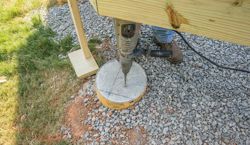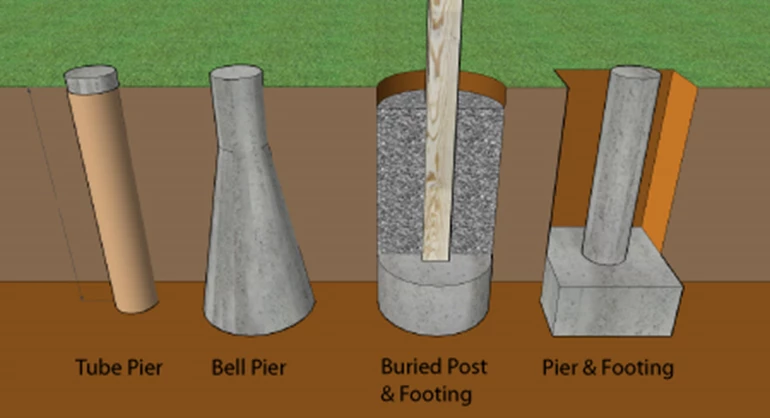Safeguard Foundations, Lasting Perceptions: Mastering the Art of Deck Footings Setup
Wiki Article
Ensure Stability and Durability With Appropriately Set Up Deck Footings
Deck footings may not be the most extravagant facet of deck construction, yet they play an important function in making certain security and long life. In this conversation, we will explore the value of appropriate deck footings, factors to consider during installation, different kinds of grounds available, detailed setup guide, and upkeep pointers for guaranteeing durable grounds.
Relevance of Appropriate Deck Footings
Why are appropriately installed deck grounds vital for the stability and durability of your deck? Deck footings are the structure on which the deck relaxes, moving the load from the deck to the ground.Firstly, properly set up deck footings disperse the weight of the deck uniformly, stopping any kind of unequal settling or sinking. This is specifically essential in locations with unsteady soil, as it helps to alleviate the risk of the deck breaking down or shifting. Furthermore, well-installed grounds guarantee that the deck remains level, preventing any type of structural damages that can happen when a deck comes to be irregular.
Second of all, properly installed grounds provide a strong anchor for the deck, preventing extreme motion and guide. This assists to preserve the architectural integrity of the deck, minimizing the danger of crashes or injuries. It additionally minimizes the damage on the deck, allowing it to endure the aspects and routine usage for a longer amount of time.
Aspects to Take Into Consideration for Deck Footing Setup
When setting up deck grounds, there are several vital factors to take into consideration for proper installation. Various soil kinds have different load-bearing abilities, so it is important to perform a dirt examination to guarantee the grounds can support the weight of the deck and its occupants. By taking right into account these elements, you can ensure the correct installment of deck grounds and delight in a secure and lasting deck.Kinds Of Deck Footings to Pick From
There are a number of various kinds of deck footings offered for you to pick from. Each kind has its very own benefits and negative aspects, so it's crucial to consider your specific requirements and the conditions of your deck prior to making a decision.One common kind of deck footing is the concrete footing. This entails digging holes in the ground and putting concrete into them to develop a solid foundation. Concrete grounds are long lasting and offer superb stability, making them ideal for decks in areas with difficult soil problems or high wind lots.
Another choice is the helical pier ground, which includes a steel shaft with helical plates that are screwed right into the ground. These footings are fast to mount and can be utilized in numerous soil types, consisting of sandy or clay soils. They are additionally adjustable, permitting easy progressing of the deck.
Sonotube grounds are an additional popular selection. These grounds are created by positioning a cardboard tube in an opening and filling it with concrete. Sonotube grounds are relatively easy to set up and give ample stability for smaller decks or in areas with much less demanding soil conditions.

When choosing the sort of deck footing, it's crucial to think about factors such as dirt problems, deck size and weight, local structure codes, and individual preferences. By selecting the ideal footing type, you can make certain the security and durability of your deck.
Step-by-Step Guide for Setting Up Deck Footings

Determine the area: Begin by noting the specific setting of each ground using stakes and string (Deck Footings). Consider any type of local structure codes or guidelines regarding trouble ranges
Dig the holes: Utilize a blog post opening digger or an auger to dig the holes for the grounds. Generally, a depth of at the very least 36 inches is advised for security.
Level the holes: Ensure that all-time lows of the openings are level (Deck Footings). This can be accomplished by using a level or a straight board across the top of the openings
Include gravel: Location a layer of crushed rock at the bottom of each hole to improve drainage and prevent the ground my website from penetrating the dirt with time.
Put the ground kinds: Insert the ground creates into the holes, ensuring they are focused and level. Usage stakes to secure them in position.
Mix and put concrete: Adhere to the guidelines on the concrete mix bag to prepare the concrete. Pour the concrete right into the footing forms, loading them entirely.
Smooth the surface: Make use of a trowel to smooth the surface area of the concrete and remove any kind of air pockets. Permit the concrete to cure according to the producer's instructions.
Maintenance Tips for Resilient Deck Footings
Appropriate maintenance is essential for making sure the durability and stability of deck footings. By regularly evaluating and preserving your deck footings, you can prevent damage and potential security dangers. One essential aspect of maintenance is to regularly look for any kind of signs of degeneration, such as fractures or activity in the grounds. It is essential to resolve them quickly to stay clear of more damages. if you see any kind of issues.Routine cleansing is additionally important for maintaining deck grounds. Debris, dirt, and plants can gather around the grounds, which can lead to moisture buildup and decay. Cleaning up the footings frequently, using a brush or a pressure washer, can help prevent these problems and prolong the lifespan of your deck.
Along with cleaning, it is important to keep the area around the footings free from any type of obstructions. Avoid stacking things against the footings or enabling plants to grow too close to them. These obstructions can trap moisture and create the grounds to wear away gradually.
Last but not least, regular resealing of the footings is suggested to safeguard them from dampness and other environmental factors. Applying a waterproof sealer can help avoid water damage and extend the lifespan of the grounds.
Conclusion
In verdict, correct setup of deck footings YOURURL.com is vital for making certain security and long life of your deck. Aspects such as soil type, lots capacity, and regional building ordinance need to be thought about when selecting the ideal type of deck footings. Following a step-by-step guide for installment and normal maintenance will help to make sure the grounds stay resilient and long-lasting.In this discussion, we will see this page explore the significance of appropriate deck footings, elements to consider throughout installation, various kinds of footings readily available, step-by-step setup overview, and maintenance pointers for ensuring long-lasting footings. Deck grounds are the foundation on which the deck relaxes, moving the load from the deck to the ground.One common kind of deck footing is the concrete footing. Place the ground kinds: Insert the footing forms right into the holes, ensuring they are focused and level.In verdict, appropriate setup of deck grounds is critical for making certain stability and durability of your deck.
Report this wiki page